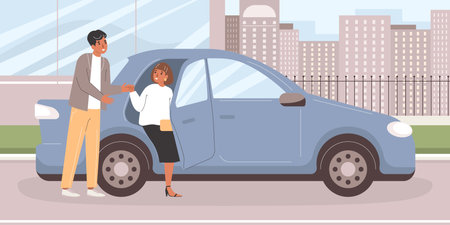Understanding Uninsured Motorist Coverage
Uninsured motorist (UM) coverage is a key part of auto insurance in the United States, designed to protect you if youre ever involved in an accident with a driver who doesnt have car insurance. In simple terms, UM coverage steps in to help pay for your medical bills, lost wages, and sometimes property damage when the at-fault driver cant cover your costs because they lack insurance. This type of protection is especially important given that, despite state laws requiring drivers to carry insurance, many people on the road still drive without it. If youre hit by an uninsured driver and dont have UM coverage, you could end up paying out-of-pocket for expenses that arent your fault. Having this coverage gives you peace of mind every time you get behind the wheel, knowing that you won’t be left financially stranded after an accident with an uninsured or even a hit-and-run driver. Each state has its own rules about UM coverage—some require it, others make it optional—so its important to know what applies where you live or travel.
2. State Requirements and Variations
When it comes to uninsured motorist (UM) coverage, the rules can be pretty different depending on where you live in the U.S. Each state has its own take on whether UM coverage is required, optional, or subject to special conditions. Let’s break down these differences so you know what to expect in your state.
States Where UM Coverage is Mandatory
Some states make it a legal requirement for drivers to carry uninsured motorist coverage as part of their auto insurance policy. This means if you’re getting car insurance in these states, your policy will automatically include UM protection—no exceptions.
| State | Mandatory Minimum Coverage |
|---|---|
| New York | $25,000 per person / $50,000 per accident (bodily injury) |
| Illinois | $25,000 per person / $50,000 per accident (bodily injury) |
| Maryland | $30,000 per person / $60,000 per accident (bodily injury) |
| Connecticut | $25,000 per person / $50,000 per accident (bodily injury) |
| Oregon | $25,000 per person / $50,000 per accident (bodily injury) |
States Where UM Coverage is Optional
In several states, uninsured motorist coverage isn’t required by law. However, insurance companies must offer it to you when you buy a policy—you can decide to accept or decline it based on your needs and budget.
| State | Offer Requirement? |
|---|---|
| California | Must be offered; can be declined in writing |
| Florida | Must be offered; can be declined in writing |
| Pennsylvania | Must be offered; can be declined in writing |
States with Unique Rules or Exclusions
A handful of states go their own way with specific rules or exclusions. For example:
- New Hampshire and Virginia: Don’t require auto insurance at all, but if you do buy it, certain UM provisions may apply.
- Kansas and North Carolina: Include both uninsured and underinsured motorist coverage as mandatory parts of a standard policy.
- Tennessee: Allows policyholders to reject UM coverage entirely if they submit a signed waiver.
- Michigan: Due to its unique no-fault system, UM coverage isn’t required and works differently from most other states.
A Quick Look: How States Handle Uninsured Motorist Coverage
| Type of Rule | Description / Example States |
|---|---|
| Mandatory UM Coverage | NY, IL, CT, MD, OR, etc. |
| Optional (Must Be Offered) | CA, FL, PA, etc. |
| No Requirement/Unique System | NH, VA, MI, etc. |
The Bottom Line for Drivers
No matter where you live, it pays to understand your state’s stance on uninsured motorist coverage. Some places make it automatic; others leave it up to you. Make sure to check your local laws or ask your insurance agent so you’re not caught off guard if you ever need this important protection.

3. How Much Coverage Do You Need?
When it comes to uninsured motorist (UM) coverage, one of the most common questions is: “How much is enough?” The answer depends on your state’s legal requirements and your own financial situation. Here’s some practical advice from American insurance experts and trends from across the country to help you make a smart choice.
Start with State Minimums—But Don’t Stop There
Every state that requires UM coverage sets its own minimum limits, but these often only provide basic protection. For example, in Illinois, the minimum is $25,000 per person and $50,000 per accident. While meeting state law is necessary, most insurance companies suggest going beyond the bare minimum for better peace of mind.
Advice from Insurance Companies
Major insurers like State Farm and GEICO recommend selecting UM coverage that matches your liability limits. That means if you have $100,000/$300,000 in bodily injury liability, you should consider the same amount for UM. This ensures you and your family are protected up to the same level as others would be if you caused an accident.
Regional Preferences
Your location can also influence how much UM coverage makes sense. In states with higher rates of uninsured drivers—like Florida or Mississippi—people often opt for higher limits or even add underinsured motorist (UIM) protection. In contrast, in states where uninsured rates are lower, drivers might stick closer to the minimums.
The Bottom Line: Protect Yourself First
Most people choose at least $50,000/$100,000 in UM coverage to cover medical bills and lost wages after a serious accident. Remember, if an uninsured driver hits you, this may be your only safety net. It’s always wise to review your personal assets and talk to a local insurance agent before deciding on your policy limits.
4. What Happens If You’re Hit by an Uninsured Driver?
Getting into an accident is stressful enough, but finding out the other driver doesnt have insurance can make things even more complicated. Don’t worry—if you have uninsured motorist (UM) coverage, you’re not left stranded. Here’s a practical, step-by-step guide on what to do next and how your coverage steps in to help.
Step-by-Step: What to Do After an Accident with an Uninsured Driver
- Stay Calm and Check for Injuries
If anyone is hurt, call 911 immediately. Your safety comes first. - Call the Police
Always file a police report, especially when the other driver has no insurance. This documentation will be crucial for your claim. - Gather Information
Get the other drivers name, contact info, license plate number, and details about their vehicle—even if they’re uninsured. - Collect Evidence
Take photos of the accident scene, damages, and any visible injuries. Get witness contact information if possible. - Notify Your Insurance Company
Contact your insurer as soon as possible to start the claims process under your uninsured motorist policy. - Follow Up on Your Claim
Your insurer will investigate the accident using your police report and evidence. They’ll explain what’s covered and guide you through repairs or medical payments.
How Uninsured Motorist Coverage Protects You
| Type of UM Coverage | What It Covers | Typical Scenarios |
|---|---|---|
| Bodily Injury (UMBI) | Your medical bills, lost wages, pain & suffering | You or passengers are injured by an uninsured driver |
| Property Damage (UMPD) | Repairs to your vehicle or property (varies by state) | Your car is damaged by an uninsured driver |
The Big Benefit: Peace of Mind
If you live in a state where UM coverage is required or recommended, having it means you don’t have to pay out-of-pocket for someone else’s mistake. Even if you’re hit by a hit-and-run driver (which counts as “uninsured” in most states), your policy can cover you.
Quick Tip:
If you’re unsure about your coverage limits or whether you have UMPD along with UMBI, check with your insurance agent. Every state handles this differently!
5. Tips for Navigating Claims and Disputes
Be Proactive with Your Insurance Company
If you’re involved in an accident with an uninsured motorist, contact your insurance company as soon as possible. Timely reporting is often required by state law or by your policy. Provide all requested documentation, such as police reports, photos, and witness statements. Keep detailed records of all communications with your insurer.
Avoid Common Claim Pitfalls
One major mistake drivers make is failing to understand their own coverage. Review your policy details so you know what’s included under uninsured motorist coverage. Don’t accept the first settlement offer if it doesn’t fully cover your losses—insurers may try to settle quickly for less than you deserve. Always get repair estimates from reputable sources and don’t sign any waivers before reviewing them carefully.
Understand Your Rights Under State Laws
Your rights can vary widely depending on where you live. Some states require insurers to offer uninsured motorist coverage, while others make it optional. Learn about the specific laws in your state by checking with your state’s Department of Insurance or a local attorney. If you feel your claim has been unfairly denied or delayed, most states have complaint processes through regulatory agencies that oversee insurance companies.
Consider Professional Help for Disputes
If you hit a roadblock with your insurer—like a denied claim or a lowball settlement—you may want to consult a lawyer who specializes in auto insurance disputes. Many attorneys offer free consultations and only charge if you win your case. This can help level the playing field when dealing with big insurance companies.
Stay Organized and Persistent
Keep copies of every document related to your claim, including emails, letters, and notes from phone calls. Persistence pays off: follow up regularly and escalate issues when necessary. By knowing your rights and being prepared, you’ll have a much better chance of getting the compensation you deserve under your state’s uninsured motorist laws.
6. Recent Trends and Future Changes
Uninsured motorist (UM) coverage laws are always evolving, so it’s smart to stay up-to-date. Over the past few years, several states have either strengthened their UM requirements or made it easier for policyholders to use their coverage after an accident. For example, some states now require insurance companies to offer higher minimum UM limits, while others are streamlining the claims process so drivers can get help faster when hit by an uninsured driver.
What’s Trending Now?
One big trend is a growing push toward mandatory UM coverage in states where it used to be optional. More lawmakers are recognizing that with rising numbers of uninsured drivers, consumers need stronger financial protection. There’s also been a lot of buzz around “stacking” UM policies—allowing drivers to combine coverage from multiple vehicles for extra peace of mind. While not every state allows stacking, this is something that could become more common as consumer demand grows.
Technology & Claims Process Improvements
Insurers and regulators are also using new technology to make filing a UM claim less stressful. Mobile apps and online portals now help you report accidents, upload photos, and track your claim status without long phone calls or paperwork headaches. This tech-forward approach is making UM coverage more accessible and user-friendly.
Looking Ahead: What Could Change?
In the near future, expect to see even more states revisiting their UM laws—possibly raising minimum required limits or tightening penalties for driving uninsured. Some experts predict national standards for UM coverage could come into play if state-by-state differences become too confusing for consumers. Keeping an eye on local legislation and checking your policy yearly will make sure you always have the right protection, no matter what changes are ahead.


